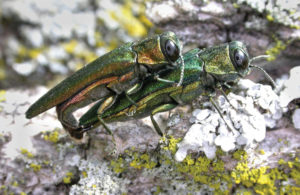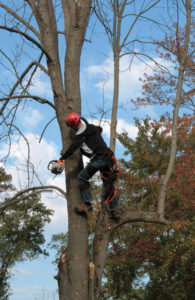Ash: The Long Goodbye
The emerald ash borer is the most destructive forest insect to invade the U.S. What can be done?

A few years ago, a forester discovered what’s believed to be the tallest American chestnut tree in its native range, from Maine to Mississippi. The 95-foot tree is located in woodlands in a small town in southwestern Maine. About 100 years ago—when one in every four hardwood trees in North America’s eastern forests was an American chestnut—this tree would have been decidedly unremarkable. But, in 1904, a strange fungus was found on the chestnut specimens at the Bronx Zoo. By 1940, most mature chestnuts had been wiped out by the blight.
The number of large surviving trees within the American chestnut’s former range is now probably fewer than 100, but among them researchers hope to find the key to re-establishing this majestic tree species. By crossing old survivor chestnuts, like the specimen in Maine, to one another, scientists hope to breed a pure American chestnut with blight resistance.
Future of Native Ash Trees
Tom Kershner, arborist and tree management coordinator for nonprofit Natural Lands (formerly Natural Lands Trust), is thinking of the future of another native tree species as he drills a small hole to insert a tap at the base of a white ash growing along a trail at Binky Lee Preserve in Chester Springs—one of the conservation organization’s 43 nature preserves. Once the tap is installed, Kershner injects a pesticide called Tree-age into the cambium layer where it will be taken up by the tree’s vascular system and protect it (hopefully!) from the emerald ash borer.

An Asian insect first identified in Detroit in 2002, the emerald ash borer has become the most destructive forest insect ever to invade the U.S. It’s now one of the most damaging pests ever seen in North America—comparable to the chestnut blight and Dutch elm disease.
There are 16 ash species and an estimated eight billion ash trees in North America—all of them are susceptible. In southeast Michigan, scientists have documented 99 percent mortality in infested trees. In 2007, emerald ash borer invasion was noted in western Pennsylvania and has been moving steadily east ever since.
Natural Lands owns nearly 23,000 acres of land, including 3,600 acres in Chester County, so the organization’s approach to emerald ash borer is a pragmatic one. Staff members are systematically taking down ash trees that are likely to become hazardous when they die—those within 100 feet of a road, building, parking lot or place where people congregate or rest, such as a bench or kiosk.
“Dead ash trees become brittle very quickly and become dangerous,” says Kershner. “We take our role as stewards of these preserves seriously and, unfortunately, that sometimes means taking down trees. Sadly, with emerald ash borers, it looks like we’ll be taking down a lot of trees.”
If circumstances dictate, a more drastic approach may be needed. In 2016, a two-acre grove of ash trees at Hildacy Preserve in Media was proactively removed and sold for lumber. Though gut-wrenching, the decision was not a difficult one. “We’re in the business of preserving and planting trees, not logging them,” says Kershner. “But a dead tree has little timber value. Since these trees will all die soon, it’s better to log them now and use the proceeds to restore the area.”

On a more hopeful note, Natural Lands’ experts have identified notable, robust ash specimens on the preserves that will be inoculated and saved, if possible. The injection equipment and chemicals needed to protect ash trees from infestation are expensive, and so it’s not feasible to treat all the hundreds-of-thousands of ashes. “The hope is that we can inoculate a few special and hearty trees against the borers so they can serve as a seed source for future ashes,” Kershner says.
Although the emerald ash borer will have a significant impact, the vast majority of our forests have the diversity to survive the borer’s punch and continue to provide important environmental, ecological and recreation benefits.
For more information and options for home-owners, visit the PA Department of Conservation and Natural Resources site’s page on emerald ash borer: DCNR.PA.gov. Natural Lands is dedicated to preserving and nurturing nature’s wonders while creating opportunities for joy and discovery in the outdoors. As our region’s oldest and largest land conservation organization, Natural Lands has preserved more than 125,000 acres, including 43 nature preserves. Some 2.5 million people live within five miles of land under the organization’s protection. Land for life, nature for all, NatLands.org.
Signs of an Infestation
All native North American ash species and cultivars are susceptible to emerald ash borer. Check for these signs:
- Upper crown dieback
- Bark splits
- Bark flaking
- Epicormic branching
- Tissue damage resulting from woodpecker predation
- D-shaped adult beetle exit holes in the bark
- S-shaped larval feeding galleries just below the bark
Source: PA Department of Conservation and Natural Resources
Our Favorite Resources
- Berk Hathaway Holly Gross
- Berk Hathaway Country Prop
- Chester Cty Community Fdn
- Chester Cty Hosp, Penn Med
- Chester Cty Library System
- Colonial Theatre
- Delaware Museum of Nat & Sci
- Key Financial, Inc.
- King Construction
- Mercedes Benz
- Osher Lifelong Learning
- Ron’s Original
- Tim Vaughan
- West Chester BID
- Walter J. Cook
